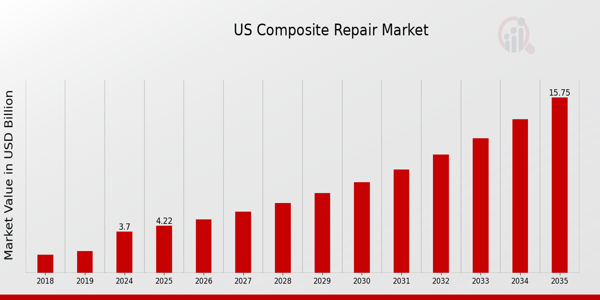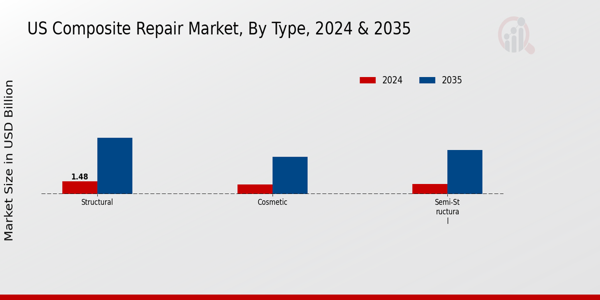US Composite Repair Market Research Report: By Type (Structural, Semi-Structural, Cosmetic), By Process (Hand Lay-Up, Vacuum Infusion, Autoclave, Others) and By End User (Aerospace & Defense, Wind Energy, Automotive & Transportation, Marine, Construction, Pipes & Tanks, Others) - Forecast to 2035.
US Composite Repair Market Overview:
As per MRFR analysis, the US Composite Repair Market Size was estimated at 3.05 (USD Billion) in 2023. The US Composite Repair Market Industry is expected to grow from 3.7(USD Billion) in 2024 to 15.75 (USD Billion) by 2035. The US Composite Repair Market CAGR (growth rate) is expected to be around 14.075% during the forecast period (2025 - 2035).
Key US Composite Repair Market Trends Highlighted
The US Composite Repair Market is witnessing a shift towards advanced materials and sustainable practices. Key market drivers include a rising demand for lightweight and durable materials, particularly in industries such as aerospace and automotive, where efficiency and fuel savings are critical. Innovations in composite repair techniques, such as the increasing use of robotics and automation, are enhancing repair procedures and reducing downtime for industries heavily reliant on composite materials. Opportunities to be explored or captured arise from the growing focus on sustainability. The push for eco-friendly technologies is prompting manufacturers to look for ways to recycle or repurpose composite materials, opening new avenues for growth in the repair segment.Additionally, government initiatives in the US are promoting the use of composites in infrastructure projects, creating demand for reliable repair solutions. Trends in recent times show a significant increase in research and development activities aimed at enhancing the properties of composite materials, thus extending their lifespan and improving repair methods. Furthermore, digitization is impacting the market, with the introduction of sophisticated monitoring systems that can detect damages early and optimize repair processes. The expansion of the aerospace sector, backed by government support, further drives advancements in composite repair methods as companies seek to improve the longevity and performance of their fleets.Overall, the US Composite Repair Market is evolving rapidly, responding to both technological innovations and broader shifts towards sustainability.

Source: Primary Research, Secondary Research, MRFR Database and Analyst Review
US Composite Repair Market Drivers
Growing Demand in Aerospace and Automotive Industries
The United States Composite Repair Market Industry is experiencing significant growth driven by the increasing demand for composite materials in both the aerospace and automotive sectors. A major player, the Federal Aviation Administration (FAA), has reported that the use of composite materials in aircraft manufacturing has surged by approximately 20% over the last five years. This trend highlights the growing reliance on composites for their lightweight and durable properties, enabling manufacturers to improve fuel efficiency and safety.In the automotive sector, Electric Vehicle (EV) manufacturers like Tesla are increasingly adopting composite materials to enhance vehicle performance and extend battery life, which further amplifies the demand for composite repairs. According to the U.S. Department of Transportation, the number of EVs registered in the U.S. has surged by over 50% in the past two years, indicating a shift towards more sustainable technologies that favor composite materials.
Increasing Infrastructure Investment
The US Composite Repair Market Industry is benefitting from increased investments in infrastructure projects, which are critical in enhancing the nation’s transportation and utility networks. The American Society of Civil Engineers (ASCE) has estimated that the U.S. will require nearly 4.5 trillion USD in infrastructure spending by 2025, prompting a surge in demand for composite materials that offer long-lasting and sustainable repair solutions. Composites are being increasingly used in the construction of bridges, roadways, and other infrastructure due to their corrosion resistance and strength.As government initiatives prioritize upgrading old infrastructure, the necessity for composite repair solutions is expected to grow, driving market growth significantly.
Technological Advancements in Composite Materials
Advancements in Research and Development (R&D) of composite materials are significantly influencing the US Composite Repair Market Industry. Innovations such as self-healing composites and advanced resin technologies are being pioneered by leading institutions like the Georgia Institute of Technology and industry leaders such as Hexcel Corporation. The National Science Foundation (NSF) has allocated substantial funding for research into new composite properties and applications, indicating a commitment to enhancing the market’s technological landscape.With improved materials, repairs can be made faster, more efficiently, and with greater longevity, which boosts market confidence and attracts further investments to the composite repair segment.
Rising Environmental Regulations
The regulatory landscape in the United States is becoming increasingly stringent with respect to environmental standards, which bodes well for the US Composite Repair Market Industry. Organizations such as the Environmental Protection Agency (EPA) are imposing tighter regulations on material use and waste management, encouraging the adoption of eco-friendly composite solutions. For example, the EPA has mandated a reduction in carbon emissions from construction activities, prompting contractors to switch to lighter and more sustainable composite materials for repairs.As companies strive to comply with these regulations, the need for composite materials and their repair solutions is projected to grow significantly, indicating a strong growth trajectory for the market.
US Composite Repair Market Segment Insights:
Composite Repair Market Type Insights
The US Composite Repair Market is experiencing significant growth, particularly within the Type segment, which is primarily categorized into Structural, Semi-Structural, and Cosmetic repairs. This segment is pivotal as it addresses a variety of applications and industries, including aerospace, automotive, and construction, making it a cornerstone of modern engineering advancements. Structural repairs, which typically involve the integrity and strength of a composite material, are essential for applications that demand high performance and durability. This aspect of the market holds substantial importance due to its demand in critical sectors, ensuring safety and reliability in various structures and vehicles.On the other hand, Semi-Structural repairs play a vital role in enhancing the functionality of composite materials. These repairs often target areas where moderate strength is required, allowing for a balance between performance and cost-effectiveness. The growing use of semi-structural composites in automotive and aerospace sectors highlights its importance as manufacturers increasingly seek lightweight solutions that do not compromise on safety or reliability.Cosmetic repairs, while often seen as less critical, hold significant weight in the overall perception of composite materials in the market. The aesthetic appearance of a product can greatly influence consumer choices, making cosmetic repair solutions crucial for maintaining brand reputation and customer satisfaction. As industries continue to innovate and push the boundaries of composite technology, the need for effective cosmetic repairs is expected to rise, adding to the appeal and longevity of composite products.In the US, various factors such as increasing demand for lightweight and high-performance materials, advancements in repair technologies, and a growing focus on sustainability are driving the US Composite Repair Market. These insights showcase the varied and essential roles played by different types, underlining their corresponding importance in meeting industry requirements and responding to marketplace dynamics effectively. Keeping abreast of these trends and the interplay between these types can provide valuable insights into the overall evolution and potential of the US Composite Repair Market.

Source: Primary Research, Secondary Research, MRFR Database and Analyst Review
Composite Repair Market Process Insights
The Process segment of the US Composite Repair Market plays a pivotal role in the overall growth and development of the industry. This segment includes various techniques such as Hand Lay-Up, Vacuum Infusion, Autoclave, and others, which are crucial for the manufacturing and maintenance of composite materials used in various applications, including aerospace, automotive, and wind energy industries. Hand Lay-Up is often favored for its simplicity and cost-effectiveness, making it a popular choice for small-scale projects. Vacuum Infusion, on the other hand, offers improved material utilization and lower emissions, contributing to sustainable manufacturing practices.The Autoclave process is significant for its ability to deliver high-quality components with superior mechanical properties, which is vital in demanding applications like aerospace. Each method presents unique advantages that meet specific industry requirements, making this segment integral to the overall performance and durability of composite materials. Recent trends emphasize innovative technologies and automation, enhancing efficiency and precision in these processes, which ultimately drives market growth in the US Composite Repair Market.As composite materials gain traction in various sectors due to their lightweight and strength characteristics, the emphasis on efficient repair processes becomes increasingly critical. A focused approach on these methods is likely to yield significant advancements in maintaining and enhancing composite integrity, thereby supporting the expanding market.
Composite Repair Market End User Insights
The US Composite Repair Market is diverse, driven by various end-user industries that leverage the benefits of composite materials. The Aerospace and Defense sector is particularly notable for its demand for lightweight materials that offer high strength-to-weight ratios, contributing significantly to performance and fuel efficiency in aircraft designs. Wind Energy is another rapidly growing segment, benefiting from the need for durable composite materials that enhance turbine efficiency and longevity. The Automotive and Transportation industry utilizes composites for weight reduction and improved fuel economy, aligning with government regulations aimed at reducing carbon footprints.The Marine sector also stands out, where composites provide resistance to corrosion and enhanced structural integrity for vessels. Construction applications are expanding as architects and builders increasingly opt for composites to enhance building durability and aesthetic appeal. Additionally, the Pipes and Tanks sector is vital for infrastructure, demanding solutions that can withstand harsh conditions while minimizing maintenance costs. Other industries also contribute to the market, showcasing the versatility of composite repair solutions across a range of applications.Overall, the US Composite Repair Market segmentation reflects a wide array of opportunities driven by technological advancements and sustainability trends across these various end-user industries.
US Composite Repair Market Key Players and Competitive Insights:
The US Composite Repair Market is characterized by a dynamic and rapidly evolving competitive landscape, driven by the increasing demand for effective and durable repair solutions across various industries, including aerospace, automotive, and construction. This market is marked by the presence of several key players who leverage advanced materials and technologies to meet the diverse needs of consumers and industries alike. The competition is fueled by technological innovations, strategic partnerships, and a focus on sustainability, which are all critical factors influencing the market's growth and direction. Companies are engaging in extensive research and development to enhance product offerings, improve service delivery, and gain a competitive edge in an ever-changing environment. As the market continues to expand, companies are also exploring various strategies such as mergers, acquisitions, and collaborations to bolster their market presence and diversify their product portfolios.Arkema SA has established a strong foothold in the US Composite Repair Market, capitalizing on its expansive range of high-performance materials. The company is renowned for its innovation and commitment to sustainability, leading to the development of advanced composite repair solutions that cater to the unique challenges faced by various industries in the region. Arkema SA’s strength lies in its ability to integrate cutting-edge technologies with local expertise, allowing it to provide tailored solutions that meet the demands of the market effectively. Its reputation for quality and reliability has earned Arkema SA a loyal customer base, further solidifying its position in the competitive landscape. The company's strategic investments in research and development have also enabled it to stay ahead of market trends and customer needs, ensuring that its product offerings remain at the forefront of the composite repair sector in the US.Momentive Performance Materials plays a significant role in the US Composite Repair Market by offering a wide array of products and services designed for durability and effectiveness. The company's comprehensive portfolio includes advanced silicone-based materials that are pivotal in various repair applications, particularly in industries that require high-performance solutions. Momentive's market presence is marked by strong partnerships and collaborations that enhance its service capabilities and customer reach. The company has made strategic moves through mergers and acquisitions, allowing it to expand its technological capabilities and optimize its operational efficiencies in the US market. With a focus on innovation, Momentive Performance Materials continues to develop and introduce cutting-edge products that address the evolving needs of customers, underscoring its strengths in providing reliable and effective solutions in the composite repair landscape.
Key Companies in the US Composite Repair Market Include:
Arkema SA
Momentive Performance Materials
Hexcel Corporation
Cytec Solvay Group
Owens Corning
Mitsubishi Chemical
Lanxess AG
BASF SE
Teijin Limited
SGL Carbon
3M Company
UBE Corporation
Toray Industries
Gurit Holding AG
Huntsman Corporation
US Composite Repair Market Industry Developments
The US Composite Repair Market has been active in recent months, with notable developments from key players. In August 2023, Hexcel Corporation announced the expansion of its production capabilities, focusing on high-performance composites which are critical for aerospace and defense applications. Moreover, a partnership was formed between 3M Company and Cytec Solvay Group aimed at developing advanced bonding technologies for composite repair solutions, enhancing overall market competitiveness. In July 2023, Pompey Capital acquired a significant stake in Gurit Holding AG, leveraging this investment to improve their composite repair service offerings. Market valuation has seen a shift, driven by the increased demand for lightweight materials in sectors such as automotive and aerospace, with a growth rate projected at 5.4% annually through 2025. This surge in demand has encouraged larger companies like Arkema SA and Owens Corning to bolster their Research and Development efforts for innovative composite repair technologies. The US government's emphasis on infrastructure and sustainability also favors growth in this sector, underscoring the importance of durable and efficient composite materials. This combination of acquisitions, partnerships, and strategic growth initiatives is pivotal in shaping the competitive landscape of the US Composite Repair Market.
US Composite Repair Market Segmentation Insights
Composite Repair Market Type Outlook
Structural
Semi-Structural
Cosmetic
Composite Repair Market Process Outlook
Hand Lay-Up
Vacuum Infusion
Autoclave
Others
Composite Repair Market End User Outlook
Aerospace & Defense
Wind Energy
Automotive & Transportation
Marine
Construction
Pipes & Tanks
Others
Report Scope:
| Report Attribute/Metric Source: |
Details |
| MARKET SIZE 2018 |
3.05(USD Billion) |
| MARKET SIZE 2024 |
3.7(USD Billion) |
| MARKET SIZE 2035 |
15.75(USD Billion) |
| COMPOUND ANNUAL GROWTH RATE (CAGR) |
14.075% (2025 - 2035) |
| REPORT COVERAGE |
Revenue Forecast, Competitive Landscape, Growth Factors, and Trends |
| BASE YEAR |
2024 |
| MARKET FORECAST PERIOD |
2025 - 2035 |
| HISTORICAL DATA |
2019 - 2024 |
| MARKET FORECAST UNITS |
USD Billion |
| KEY COMPANIES PROFILED |
Arkema SA, Momentive Performance Materials, Hexcel Corporation, Cytec Solvay Group, Owens Corning, Mitsubishi Chemical, Lanxess AG, BASF SE, Teijin Limited, SGL Carbon, 3M Company, UBE Corporation, Toray Industries, Gurit Holding AG, Huntsman Corporation |
| SEGMENTS COVERED |
Type, Process, End User |
| KEY MARKET OPPORTUNITIES |
Aerospace industry maintenance growth, Infrastructure repair and reinforcement, Increasing wind energy installations, Automotive lightweighting demand, Advanced manufacturing technologies adoption |
| KEY MARKET DYNAMICS |
Growing infrastructure investment, Increasing adoption of advanced materials, Expanding aerospace and automotive sectors, Rising demand for sustainable solutions, Technological advancements in repair processes |
| COUNTRIES COVERED |
US |
Frequently Asked Questions (FAQ) :
The US Composite Repair Market is expected to be valued at 3.7 USD billion in 2024.
By 2035, the US Composite Repair Market is anticipated to reach a valuation of 15.75 USD billion.
The expected CAGR for the US Composite Repair Market from 2025 to 2035 is 14.075%.
The structural composite repair segment is forecasted to have the largest market value of 6.45 USD billion in 2035.
Major players in the US Composite Repair Market include Arkema SA, Momentive Performance Materials, and Hexcel Corporation.
The semi-structural composite repair segment is expected to reach a market size of 5.05 USD billion by 2035.
The cosmetic composite repair segment is projected to be valued at 1.08 USD billion in 2024.
The structural segment is anticipated to exhibit the fastest growth within the US Composite Repair Market.
Emerging trends in the US Composite Repair Market include increased use in aerospace applications and advancements in repair technologies.
Challenges facing the US Composite Repair Market include high repair costs and the need for specialized technicians.
















